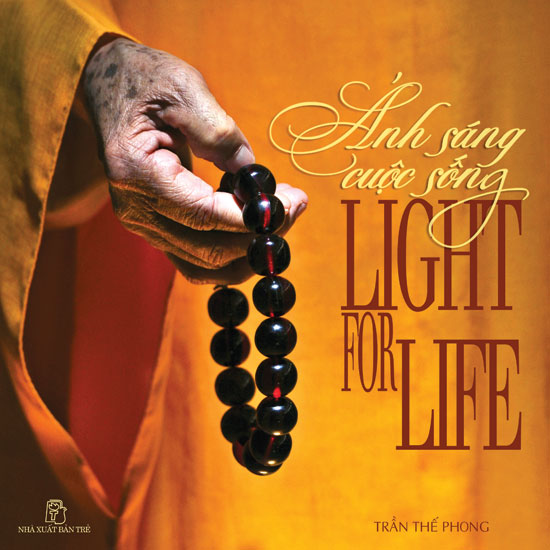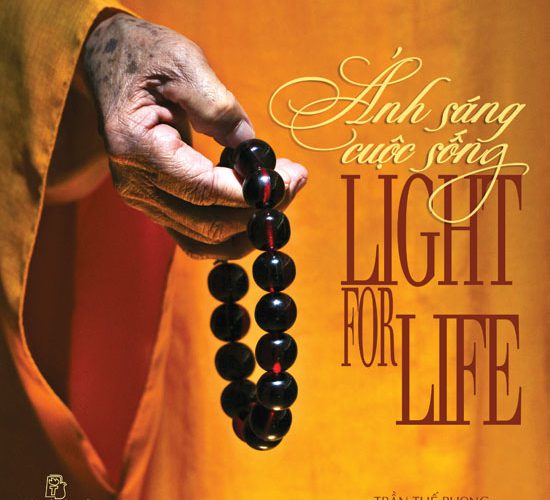(No.5, Vol.6,Jul-Aug 2016 Vietnam Heritage Magazine)

Photo book shows slices of life
along the Middle Way
What do Buddhist monks and nuns do all day long? Many people may think they must occupy their time sitting under trees and meditating or trudging slowly through streets with begging bowls in their hands. Tran The Phong, a devoted Buddhist himself has produced an album of photographs to shatter such myths and show you that while they be not be of the world they are very
definitely in it.
The book begins with showing monks and nuns care for the young, presumably at an orphanage. Then we see images of juniors in Buddhist robes. Mostly they are
playing like normal children at chess, tug-of-war and arm wrestling but also feeding small animals and tending to flowers. This led me to reflect on my early Christian upbringing and Sunday school, which was all about acquiring knowledge. The emphasis here seems to be opening up kids to religious experience.
At the other end of life, there is a convent where the nuns give residential care to many geriatric females. I have visited this place with a Japanese charity and can bear witness to the saintliness of these people. They are Buddhist Saint Teresas and deserve at least a nomination for the Nobel Peace Prize. You see the nuns in packed wards, chatting to families old ladies and feeding and washing them.
You may think monks do not actually do work. Phong shows you otherwise. He has captured them at gentle pursuits such as gardening, cooking, painting, sweeping floors and washing cars. However, to put sedentary folk like me to shame, he also has caught them at hard physical labour; hauling huge stones, pushing heavily-laden carts and road building. Glad to see these chaps are not corrupt like our Christian monks who were instrumental in concocting some delicious beers and wines. The nearest to that here is a shot of a monk making soya sauce.
Many monasteries are centres for Eastern martial arts. Here you can see pictures of child monks thrusting out their fists with extreme concentration on their faces. An elderly monk demonstrates how to fell an opponent while seated child monks look on. The fact that this takes place in the tranquillity of woods gives contrast to the action. Another monk’s physical and mental absorption is shown as he practices tai chi with a large fan outspread.
Another monastic pursuit is medicinal gardening and the preparation of herbal remedies. Monasteries with their pharmacies are a good place to source traditional medicine. Nuns are pictured watering the greenery and tending to the plants. Another is joyfully carrying away a basket of freshly harvested herbs. Then there are nuns raking through carpets of herbs while others sort through them in baskets. Presumably there are looking for the best picks. Finally, two nuns are shown serving a mother and young child in the pharmacy.
Like the rest of us, monks and nuns have to eat and there is a series on the monastic kitchen. A group of monks sit down together to make banh chung for the Tet festival. One cook is sweating away over a steaming pan. Another portrait which might be entered for a prize has a black robed monk sampling soup from a ladle surrounded by huge aluminium pots. He is cooking for a hungry mass.
The word ‘light’ comes in the title and this photographer uses light to great effect when shooting his subjects. He also has an eye for colour. Light is, of course, a religious word too. There is a huge sense of joy on the faces of the people and in the scenes portrayed. It made me feel quite envious of the monastic way of life.
The cover page picture is of a monk’s hand holding a rosary. The final pages feature processions, including one over an iconic Hanoi bridge. On the very final page appears the cliché of a saffron-robed monk meditating under a tree. This is a photo album where you get not what you may have bargained for-full action monastic life.



‘The Light for Life’ by Tran The Phong is published by Nha Xuat Ban Tre at VND360,000. It won the prize A – Excellent National Photography Award from Vietnam Association of Photographic Artists in 2015. The book can be found at Tribooks, 158 Dong Khoi St, Dist.1, Ho Chi Minh City.

